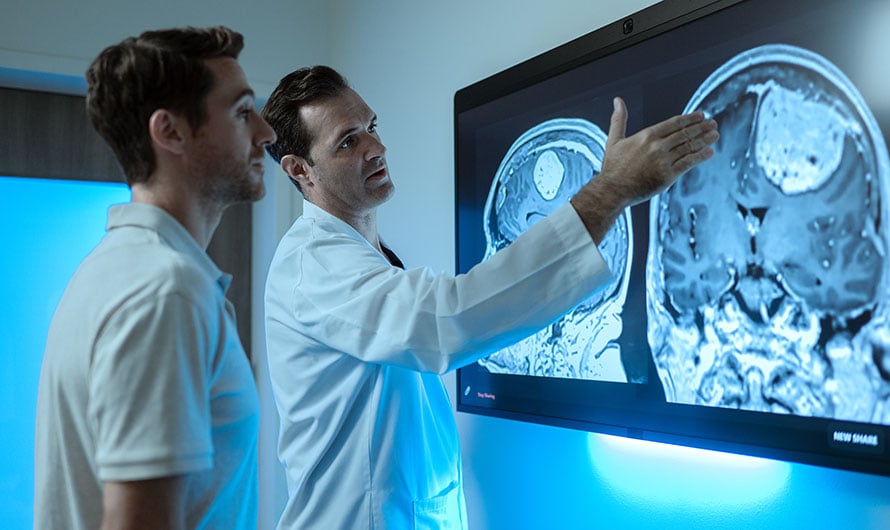Navigating New Frontiers: Far Medial Technique in Minimally Invasive Brain Tumor Surgery
In the dynamic landscape of delicate brain tumor surgery, the focus has shifted towards minimizing invasiveness and optimizing patient outcomes. One intricate challenge lies in the clivus region—a complex area at the base of the skull where precision is paramount. Traditional transcranial approaches to clivus surgery can pose certain risks and complications, necessitating a move towards innovative, minimally invasive techniques such as the far medial approach.

Clivus Lesions & Surgical Approaches
For lesions requiring surgery in the clivus region, navigating these intricate structures near the base of the brain requires high precision. With traditional transcranial and trans-facial approaches, surgeons face challenges maneuvering around critical structures to avoid damage during skull base surgery. These approaches often lead to more brain tissue and soft tissue retraction that can lead to functional and cosmetic issues and increased risk of perioperative complications.
Lesions that may lead to the consideration of clivus surgery include:
- Chordomas: Chordomas are rare, slow-growing tumors occurring at the base of the skull or along the spine. They can affect both adults and children.
- Chondrosarcomas: Chondrosarcomas originate in cartilage cells and can develop in the bones, including the clivus.
- Meningiomas: Meningiomas are typically benign tumors that form on the meninges, the layers of tissue covering the brain and spinal cord, that can sometimes be found in the clivus region.
- Cysts and other abnormalities: Some non-cancerous growths, cysts, or other abnormalities may also develop in the clivus region and could require surgical intervention.
Risk factors associated with the development of these abnormalities or tumors can include a history of certain genetic conditions, exposure to certain environmental factors, or other medical predispositions.
Far Medial Approach
The far medial technique represents a groundbreaking approach to skull base tumor surgery, utilizing minimally invasive methods to access and treat tumors near the brain’s base, particularly in the clivus region. While the transcranial approach accesses these abnormalities by going through the skull, the far medial approach accesses the clivus through the midline. It provides significantly larger exposure of the brainstem in the ventromedial compartment than a far lateral approach and wider exposure of the lower third of the clivus for lesions that expand to the hypoglossal nerve.
 This surgery is typically performed by skull base neurosurgeons such as Moffitt’s Dr. Andre Beer Furlan, a specialist in skull base surgeries and our expert in using the far medial expanded endonasal endoscopic approach (EEA).
This surgery is typically performed by skull base neurosurgeons such as Moffitt’s Dr. Andre Beer Furlan, a specialist in skull base surgeries and our expert in using the far medial expanded endonasal endoscopic approach (EEA).
Techniques and Challenges of Far Medial Technique
The far medial approach involves intricate procedures leveraging endonasal endoscopic approaches and specialized tools to allow greater access to tumors in the clivus region with precision.
This approach is recommended as a first-line option for lesions near the base of the brain, including clival chordomas. Using this technique for clival chordomas has shown a higher resection rate and a lower surgical complication rate compared to transcranial surgery for the treatment of the same tumors.
It also provides an effective and safe corridor to access the medial jugular tubercle and occipital condyle for lesions that displace neurovascular structures laterally as well as the ventrolateral surface of the ponto-and cervicomedullary junctions.
Accessing the area ventral to the brainstem and medial to the lower cranial nerves and vertebral artery can be particularly challenging, requiring the surgeon’s thorough understanding of the patient’s anatomy and experience performing these complicated procedures. The far medial approach provides an alternative surgical option to expand visibility and access, improving the extent of resection and patient outcomes.
Benefits of Far Medial Approach
Neurosurgeons may choose the far medial approach over other approaches to access the area near the brainstem for several reasons:
- Access to Deep-Seated Lesions: The far medial approach allows for direct access to deep-seated lesions in the clivus region that may be challenging to reach using other approaches, such as transcranial or far lateral. This gives surgeons enhanced access and ability to resect tumors in the midline and paramedian areas of the clivus.
- Preservation of Structures: This minimally invasive approach aims to minimize disruption to critical structures and nerves while reaching the target area, reducing trauma and scarring compared to traditional transcranial approaches. Preserving vital structures is crucial to avoiding complications and maintaining neurological function in patients. It also minimizes incisions and disfigurement of the patient’s face or skull.
- Faster Recovery Time: The recovery for EEA far medial approach surgery can be days rather than weeks or months associated with open surgery, allowing patients to potentially leave the hospital within a few days.
- Optimal Visualization: The far medial approach provides surgeons with optimal visualization of the surgical field, enabling them to navigate and address the pathology with precision using specialized tools such as an endoscope.
- Reduced Risk of Damage and Post-Op Complications: Since the brain does not need to be manipulated in an EEA far medial approach surgery, it reduces the likelihood of damage and presents low complication rates, allowing surgeons to better preserve vital nerves that control hearing and vision.
- Individualized Patient Considerations: The choice of surgical approach is often based on the specific characteristics and pathology of the lesion, its location, and the patient's overall health. The far medial approach may be selected when the neurosurgeons deem it the most suitable option for a particular patient’s case.
Over the past decade, EEA far medial approach has become more highly recommended with increasing indications and better results.
Referring Patients to Moffitt for Expanded Endoscopic Endonasal Surgery
The Department of Neuro-Oncology at Moffitt Cancer Center stands at the forefront of brain and skull base tumor surgery, consistently advancing techniques and technologies. Innovations such as the expanded endoscopic endonasal surgery contribute to our commitment to continually improve patient outcomes through state-of-the-art treatments.
As Moffitt’s resident expert in using this technique, Dr. Andre Beer Furlan's unique and high-demand skills offer hope to patients with tumors in the clivus region. While this approach is gaining momentum, there are still few cancer centers offering this surgery. Moffitt is proud to lead the charge in embracing this minimally invasive option to improve patient outcomes.
Moffitt's collaborative approach involves multidisciplinary teams working together for comprehensive patient care, and that collaborative approach also extends to referring providers. Working cooperatively with the physicians who refer their patients to us ensures each patient receives the best, most comprehensive care.
Referring providers are encouraged to refer eligible patients to Moffitt for consultations to explore the far medial technique.
If you’d like to refer a patient to Moffitt, complete our online form or contact a physician liaison for assistance. As part of our efforts to shorten referral times as much as possible, online referrals are typically responded to within 24 - 48 hours.
